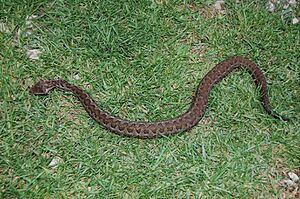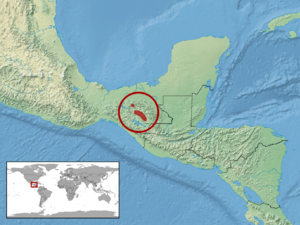Cerrophidion tzotzilorum facts for kids
Quick facts for kids Cerrophidion tzotzilorum |
|
|---|---|
 |
|
| Conservation status | |
| Scientific classification | |
| Genus: |
Cerrophidion
|
| Species: |
tzotzilorum
|
 |
|
| Synonyms | |
|
|
The Tzotzil montane pitviper (scientific name: Cerrophidion tzotzilorum) is a type of venomous snake. It's a pit viper species found only in southern Mexico. This snake does not have any recognized subspecies, meaning there aren't different types of it.
Contents
What is the Tzotzil Montane Pitviper?
This snake is known as the Tzotzil montane pitviper. Its scientific name, tzotzilorum, comes from the Tzotzil people. They are an indigenous group living in the same area where this snake is found. It's a way of honoring them.
What Does the Tzotzil Montane Pitviper Look Like?
The Tzotzil montane pitviper lives on the ground and has a moderately thick body. Adult snakes probably grow to be about 50 cm (19.5 in) long, including their tail. That's about the length of a large ruler!
Where Does the Tzotzil Montane Pitviper Live?
You can find the Tzotzil montane pitviper in the central highlands of Chiapas, Mexico. It prefers to live in forest areas. This snake was first discovered near San Cristobal de Las Casas in Chiapas, at an elevation of about 2,320 m [7,610 ft].
What Does the Tzotzil Montane Pitviper Eat?
This pitviper is a hunter. It is known to eat orthopterans, which are insects like grasshoppers and crickets. It also preys on lizards.
How Does the Tzotzil Montane Pitviper Have Babies?
Unlike some snakes that lay eggs, the Tzotzil montane pitviper is viviparous. This means the mother snake gives birth to live young, instead of laying eggs.
Is the Tzotzil Montane Pitviper in Danger?
The Tzotzil montane pitviper is listed as "Least Concern" (LC) by the IUCN Red List of Threatened Species. This means that the snake is not currently in danger of disappearing. It has a wide distribution, a good population size, and its numbers are stable. This assessment was made in 2007.
Images for kids




